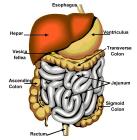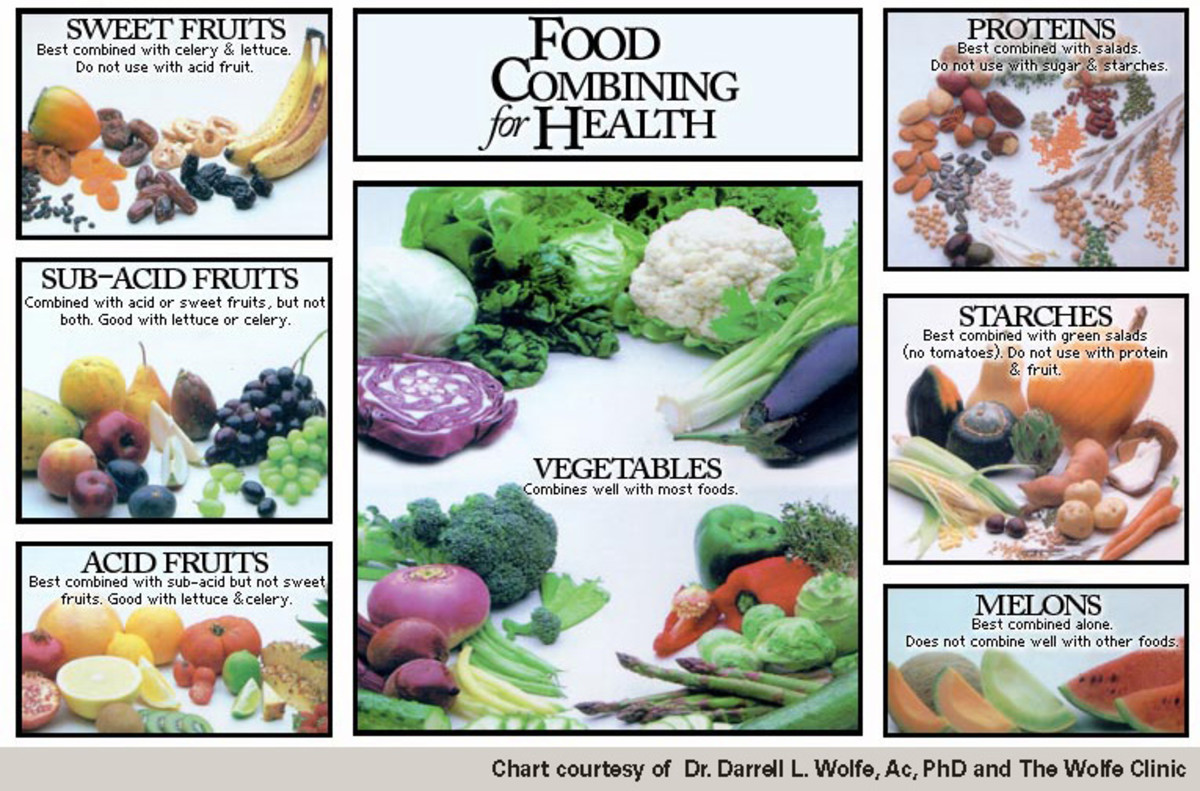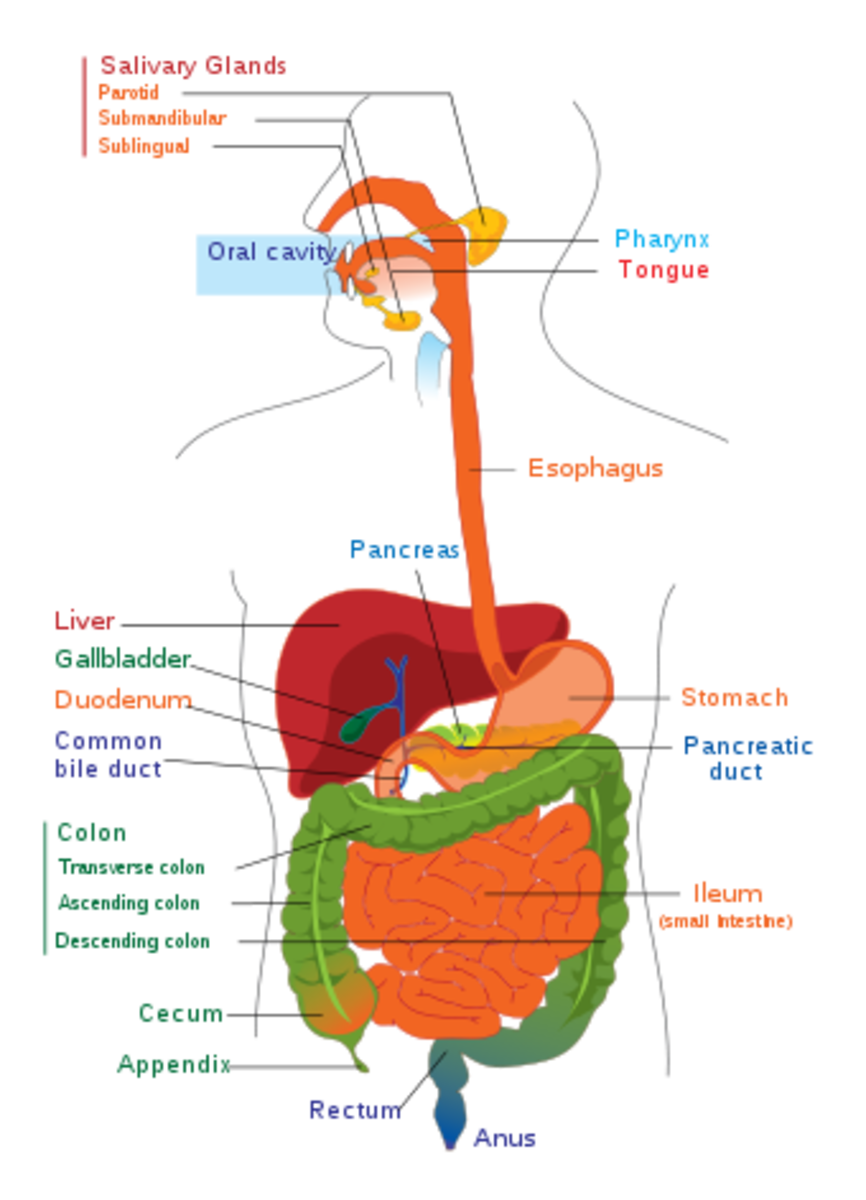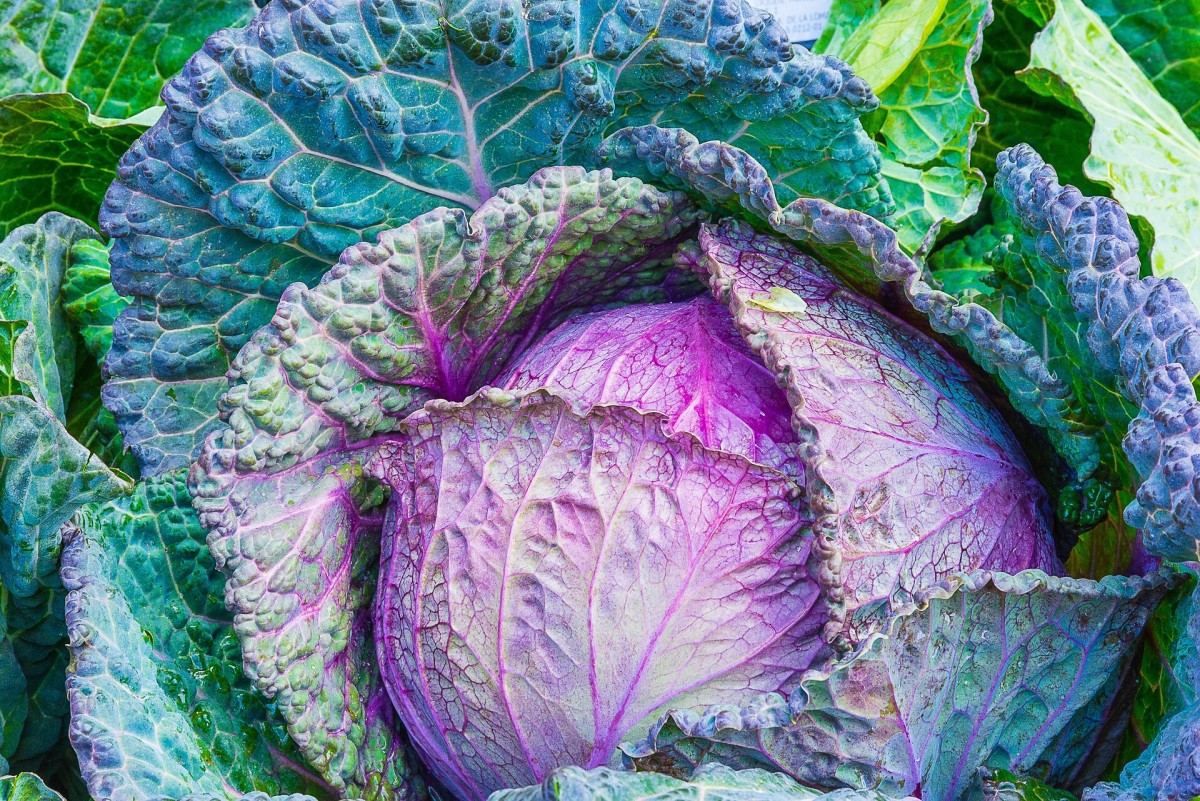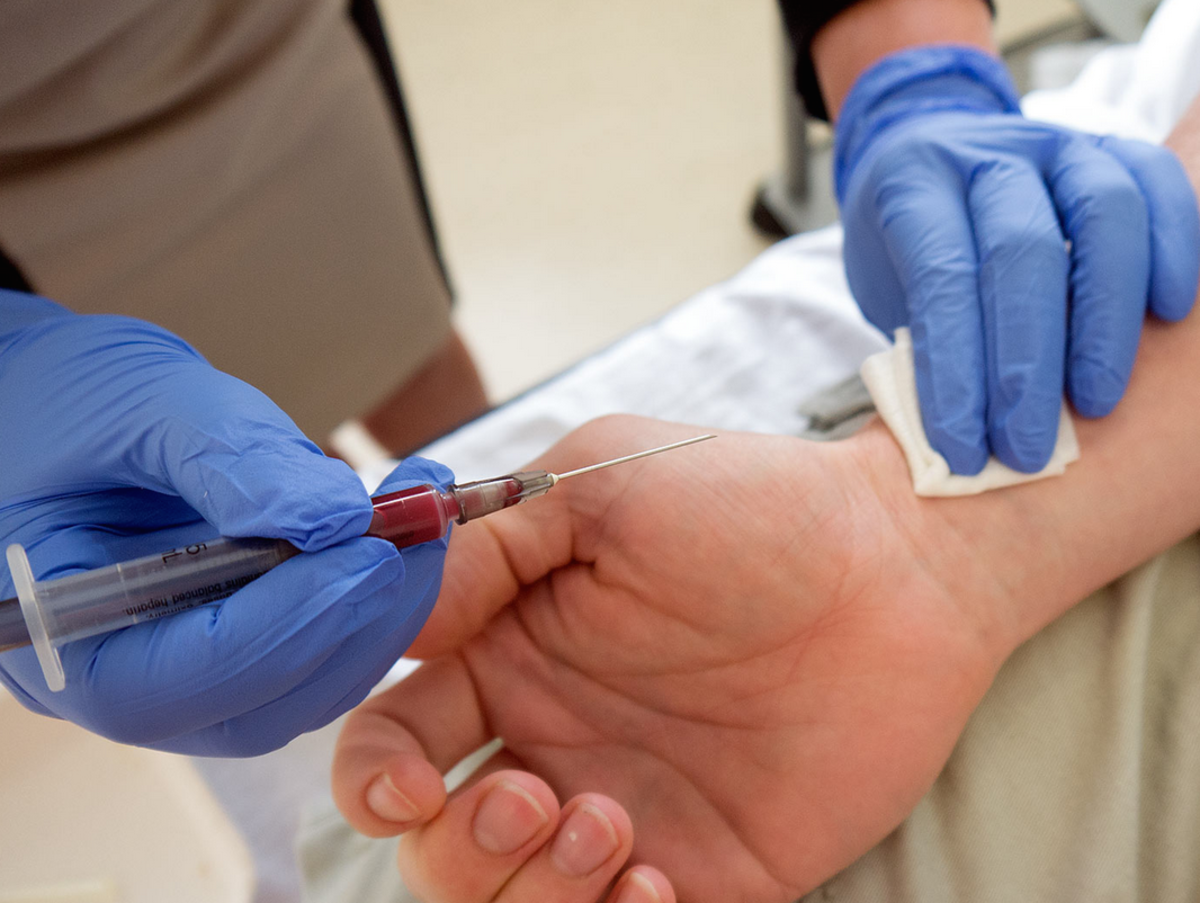Human Digestive System
Digestion begins in the mouth. Chewing is very important to good digestion. When chewed food is ground into fine particles, digestive juices, which contain enzymes can react more easily. As the food is chewed, it is moistened and mixed with saliva, which contains the enzyme ptyalin which converts some of the starches to sugar. After the food is swallowed, muscles of the pharynx push the down into the stomach. In the stomach, food is thoroughly mixed with digestive juices by a vigorous churning motion.
Digestive juice in the stomach is called gastric juice which contains hydrochloric acid and enzyme pepsin. Digestion of protein begins in the stomach. Food that is partly digested and changed into thick liquid in the stomach is called chyme. Chyme passes from the stomach into the small intestine.
Digestion is completed in the small intestine. Juices from the pancreas, liver and intestine help complete the digestive process. Pancreatic juice is produced by the pancreas and pours into the small intestine through the pancreatic duct. Pancreatic juice contains the enzymes trypsin, amylase and lipase. Trypsin breaks down protein into amino acids, amylaseconverts the starch into sugars, and lipase changes fats into fatty acids and glycerol. Intestinal juice is produced by the walls of the small intestine.It contains the enzymes sucrase, lactase, and maltase. Bile is produced in the liver, stored in the gall bladder and flows into the small intestine through the bile duct. Bile helps digest and absorb fats.
The small intestine is lined with a mucous membrane made up of tiny fingerlike projections called villi. Villi increases the area through which absorption can take place. When the food is completely digested, it is absorbed by tiny blood vessels in the walls of small intestine and then carried to all parts of the body.
Almost no digestion takes place in the large intestines. It stores waste food products and absorbs small amounts of water and minerals. The wastes that accumulate in the large intestine are roughage that cannot be digested in the body. Bacterial action produces the final waste products called feces. Feces than passes out of the body through the rectum and finally anus.
Ailments of the Digestive System
Infection of or damage to any pay of the digestive system may affect digestion as well as other bodily functions. Common infectious agents that attack digestive organs include the mumps virus, which often infects the salivary glands; the bacterium Helicobacter pylori, which causes most stomach and duodeal ulcers; and viruses and bacteria that cause various forms gastroenteritis often called stomach flu or traveler's diarrhea. Appendicitis is a an inflammation of the appendix, a tube-like pouch about 9 cm (3.5 in) long that branches off the large intestine. It occurs most commonly among children and young adults. Diarrhea - frequent elimination of loose, watery feces - is a symptom of many disorders that occurs when the large intestine is irritated or inflamed. As a result, food residues move through it too quickly for it to absorb the excess water. The opposite condition, constipation,occurs when the large intestine absorbs too much water because food residues are moving slowly. As a result, the feces become hard and dry, which may make elimination difficult.
Crohn's Disease
Crohn's disease is chronic, recurrent inflammatory disease of the intestinal tract. The primary sites of this disease are the ileum and the colon. The condition begins as small microscopic nests of inflammation which persist and smolder. The lining of the colon then becomes ulcerated and the colon wall thickened. Eventually, the colon may become narrowed.
The cause of Crohn's disease still remains unknown. One theory is that the condition is caused by an unidentified, slow-growing microorganism. The body's immune system is also thought to be a factor. Symptoms can include recurrent pan in the right abdomen, diarrhea (sometimes bloody), fever, and weight loss.
Diverticulosis / Diverticulitis
Diverticulosis means that there are pockets or projections extending out from the colon. These occur gradually over a long period of time. They occur at weak points in the colon wall. The pockets develop because of the pressure exerted with by the contracting colon. Since the segmoid colon has the highest pressure in the colon, it is here the most diverticuli occur. Because of these balloon-like projections, the sigmoid often becomes thickened and narrowed. When this happens, significant changes in the colon function can occur, such as discomfort, diarrhea, and/or constipation.
Esophagitis
When stomach acid and digestive enzymes repeated reflux into the esophagus, the tissues become inflamed and ulcerated. This inflammation is known as esophagitis. When the inflammation is severe, esophageal ulcers develop.
Heartburn occurs when acid refluxes into the esophagus. It is experienced as a burning sensation in the lower chest and may be felt up the esophagus. At times, bitter-tasting liquid may regurgitate up into the mouth. When esophagitis is severe and ulcers are present, swallowing may cause pain when food reaches this part of esophagus. If the lower esophagus narrows due to scarring, food may stick in this area. The symptom is called dysphagia and is uncomfortable. Esophagitis also may cause bleeding. Black stools, anemia, and vomiting of blood are signs of bleeding.
Gallstones
Bile is composed of many chemicals, including cholesterol, salts, and some pigments. The gallbladder absorbs water from the bile, causing it to thicken. In some people, tiny crystals form the cholesterol and pigments. These crystals grow gradually until one or even hundreds of gallstones develop. About 80% of gallstones are composed of cholesterol, while the rest are made of pigments, salts, and other chemicals.
Gastroesophageal Reflux Disease (GERD)
GERD is a very common disease of the digestive tract that is characterized by the reflux of gastric fluid from the stomach back up to the esophagus or swallowing tube. Approximately 15 percent of the adult population suffers from GERD and it occurs equally between men and women, frequently heartburn. Characteristic symptoms of GERD include frequent heartburn, difficult and painful swallowing, hoarseness, sour or bitter taste in the mouth from the reflux of stomach fluids, nighttime wheezing or coughing a feeling like you need to clear your throat repeatedly.
Hepatitis
Hepatitis is caused by any inflammation of the liver. This inflammation can be caused by many different things such as drugs, viruses, bacteria, heredity, and fatty tissue. Symptoms may include loss of taste in food, loss of taste in cigarettes, heaviness in the right-upper abdomen, and jaundice (with acute B hepatitis). No specific treatments are available for acute hepatitis. In most cases, the body develops antibodies that fight and kill the virus. For alcohol and drug-induced hepatitis, the patient has to avoid the offending agent.
Hiatus Hernia
In some people, the hiatus or hole in the diaphragm weakens and enlarges. It is not known why this occurs. It may be due to heredity, while in others it may be caused by obesity, exercises such weightlifting, or straining at stool. Whatever the cause, a portion of the stomach herniates, or moves up. Into the chest cavity through this enlarged hole. This disease in very common, occurring in up to 60% of people by age 60.
Pellagra
Pellagra is a dietary-deficiency disease resulting from inadequate intake or absorption of niacin, one of the components of the vitamin B complex. The disease mainly afflicts those whose diet lacks proteins, particularly those whose diet is principally corn, and sometimes occurs in people with gastrointestinal diseases that result in poor absorption of vitamins. The disease often begins with weakness, lassitude, insomia, and weight loss. Exposed skin on the neck, hands, arms, feet, and legs, particularly after exposure to sunlight becomes rough, reddened, and scaly, and painful mouth lesions develop. The gastrointestinal disturbances consist of loss of appetite, indigestion, and diarrhea; nervous system involvement appears later in the course of the disease and includes such symptoms as headache, vertigo, generalized aches, muscular tremors, and mental disturbances.
Cancerous tumors may develop in any part of the digestive system, though they most commonly occur in the large intestine, rectum, and anus. Colitis, which has various causes, is a potentially life-threatening inflammation of the large intestine. Chronic conditions by spasms of muscles in the lower intestine, and Crohn's disease. Abnormal sensitivity to proteins called glutens can damage the lining of the small intestine and hinder absorption of nutrients, leading to malnutrition and other problems. The eating disorders anorexia nervosa and bulimia disrupt the normal functioning of the digestive system and are potentially fatal.
